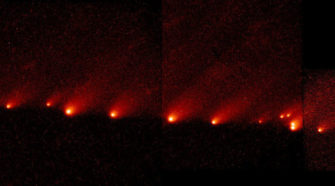Ice and Stone
Special Topic: Discoveries and Surveys
Up until a few centuries ago, all the comets that were seen by human beings were “discovered” via the unaided eye. It is unlikely that there were ever any search efforts for these objects, rather, when they appeared they essentially revealed themselves to the people who were alive at that time. Probably the closest thing …
This Week in History: July 12-18
JULY 12, 2001: American astronomer Gary Melnick and his colleagues publish their discovery of water vapor around the old, evolved star CW Leonis, suggesting the presence of exocomets around that star. The subject of exocomets, including the importance of this discovery, is discussed in a previous “Special Topics” presentation. JULY 12, 2126: Comet 109P/Swift-Tuttle, the …
Comet of the Week: Shoemaker-Levy 9 1993e
Perihelion: 1994 April 18.57, q = 5.380 AU What could perhaps be considered the most successful search program for comets and near-Earth asteroids during the photographic era, i.e., before the advent of CCD-based comprehensive survey programs in the late 1990s, was conducted by renowned planetary geologist Eugene Shoemaker from 1982 to 1994. Usually once a …
Special Topic: Pluto
The discovery of the planet Uranus by British astronomer William Herschel in 1781 essentially doubled the size of the then-known solar system. During the years after Uranus’ discovery astronomers began to notice small discrepancies in its orbital motion, and at least two individuals – a young British astronomer named John Adams, and a French mathematician, …
This Week in History: July 5-11
JULY 5, 1687: British physicist Isaac Newton publishes his Philosophiae Naturalis Principia Mathematica (Mathematical Principles of Natural Philosophy), usually known as the Principia, wherein he lays out what is now known as his Law of Universal Gravitation. Part of Newton’s work in the Principia was based upon his calculations of the Great Comet of 1680 …
Comet of the Week: 9P/Tempel 1
Perihelion: 2005 July 05.31, q = 1.506 AU With the various comprehensive survey programs that are currently operational, the discovery of previously-unknown short-period comets happens all the time these days. The situation was very different during the mid-19th Century, when only a handful of such objects were known, and the discovery of each one was …






